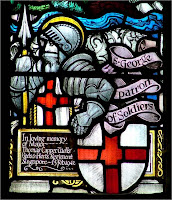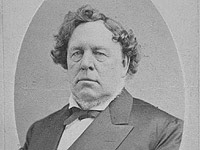by Sharon
 Today is a national holiday in England — St. George’s Day. St. George was a soldier of noble birth who served in the Roman army in the early 4th century. When the Roman Emperor Diocletian began his horrific persecutions against the Christians, George responded by giving his worldly goods to the poor and publicly confessing his Christian faith. He protested against Diocletian’s persecution of Christians and boldly disobeyed orders by refusing to sacrifice to other gods. George was beheaded by Emperor Diocletian on 23 April 303 AD. George’s example of bravery in defense of his Christian brethren and faith has encouraged individuals and nations for centuries. Today St. George is honored as the patron saint of at least nine different countries.
Today is a national holiday in England — St. George’s Day. St. George was a soldier of noble birth who served in the Roman army in the early 4th century. When the Roman Emperor Diocletian began his horrific persecutions against the Christians, George responded by giving his worldly goods to the poor and publicly confessing his Christian faith. He protested against Diocletian’s persecution of Christians and boldly disobeyed orders by refusing to sacrifice to other gods. George was beheaded by Emperor Diocletian on 23 April 303 AD. George’s example of bravery in defense of his Christian brethren and faith has encouraged individuals and nations for centuries. Today St. George is honored as the patron saint of at least nine different countries.
In case you’re wondering, St. George, Utah is not named for St. George the Christian martyr, but for early LDS Apostle George A. Smith. Brigham Young named the principle settlement of southern Utah’s 1861 Dixie Mission “St. George” in Mr. Smith’s honor.
 George A. Smith was a self-taught lawyer who, like St. George, defended his brethren. A description of Mr. Smith’s “most notorious case” is recorded in A Book of Mormons:
George A. Smith was a self-taught lawyer who, like St. George, defended his brethren. A description of Mr. Smith’s “most notorious case” is recorded in A Book of Mormons:
Howard Egan, a Mormon school teacher, had joined the California gold rush in 1849. While he was away, James Monroe seduced one of [Egan’s] wives, who gave birth to an illegitimate child. Egan returned to Utah and killed Monroe “in the name of the Lord” because his “peace on earth” had been destroyed.
[George A.] Smith argued that “in this territory it is a principle of mountain common law, that no man can seduce the wife of another without endangering his own life….The man who seduces his neighbor’s wife must die, and her nearest relative must kill him!” The jury declared Egan not guilty.
Both of these honored men are called saints. George A. Smith gained his “saint” status by virtue of his church affiliation, while George the Christian martyr was a “saint” first by virtue of his faith in Christ; later, by the forfeiture of his life in defense of — and on account of — his faith in Christ.
I once spoke with an LDS missionary who emotionally (and very mistakenly) proclaimed that the only people who had ever died for their faith were Mormons. In honor of St. George’s Day I leave you with an excerpt from the writings of early Christian historian Eusebius:
The outrageous agonies endured by the martyrs in the Theban area, however, defeat all description. Their whole bodies were torn to shreds with clawlike potsherds until they expired. Women were tied by one foot and swung high in the air, head downward, by machines, their bodies totally naked without a stitch of clothing — the most shameful, cruel, and inhumane of all spectacles for onlookers. Others died fastened to trees: they bent down their strongest branches by machines, fastened one of the martyr’s legs to each, and then let the branches fly back to their natural position, instantly tearing apart the limbs of their victims. This went on not for a few days but for some whole years. Sometimes ten or more, at times more than twenty were put to death,…at other times a hundred men, women, and little children were condemned to a variety of punishments and killed in a single day.
I myself saw some of these mass executions by decapitation or fire, a slaughter that dulled the murderous axe until it wore out and broke in pieces, while the executioners grew so tired they had to work in shifts…
Need I cite the names or numbers of the rest or the varieties of their martyrdoms? Sometimes they were killed with an axe, as was the case in Arabia, or had their legs broken, as those in Cappadocia. At other times they were hung upside down over a slow fire, so that smoke rising from the burning wood suffocated them, as in Mesopotamia. Sometimes noses, ears, and hands were mutilated and the other parts of the body butchered, as was the case in Alexandria…
In all these trials the magnificent martyrs of Christ were so distinguished throughout the world that eyewitnesses of their courage were astounded. They provided in themselves clear proof that the power of our Savior is divine and ineffable indeed. To mention each by name would be a long if not impossible task.
I saw under the altar the souls of those who had been slain for the word of God and for the witness they had borne. They cried out with a loud voice, “O Sovereign Lord, holy and true, how long before you will judge and avenge our blood on those who dwell on the earth?” Then they were each given a white robe and told to rest a little longer, until the number of their fellow servants and their brothers should be complete, who were to be killed as they themselves had been…
I saw a woman sitting on a scarlet beast…drunk with the blood of the saints, the blood of the martyrs of Jesus. (Revelation 6:9-11; 17:6)

Very timely post.
In my recent discussions with a Mormon friend, I have noticed stark differences in our understanding of martyrdom. First, I identify Christian martyrdom as something to be embraced (not necessarily sought out), a most perfect participation in Christ’s suffering (on our account nonetheless). I believe martyrdom is a fitting departure from this life for those who truly follow Christ crucified. Look at the build up to Christ’s passion, and His words in John 15:13.
My impression of the LDS take on martyrdom is that it is something to be pitied. Something that was unjust and shouldn’t have happened. When I hear Mormons speak of their modern “martyrs” and “saints”, they don’t speak of noble sacrifices that glorify God. Instead, they have examples like the ones posted here, or of Joseph Smith, who was clearly fighting back rather than willingly accepting his “martyrdom.” There is an uneasiness that I sense in their faith regarding martyrdom, as though it should be avoided rather than embraced, and whenever they have as an institution faced great persecution, it seems as though God conveniently reveals a different and more socially acceptable teaching.
Martyrdom is a mark of courage and fidelity to the Truth, but LDS writers look back upon the martyrs of the early Church and claim to see apostacy. (See, e.g., http://beta.lds.org/portal/site/LDSOrg/menuitem.b12f9d18fae655bb69095bd3e44916a0/?vgnextoid=2354fccf2b7db010VgnVCM1000004d82620aRCRD&locale=0&sourceId=cf63fd758096b010VgnVCM1000004d82620a____&hideNav=1) The allegations regarding Ignatius in the link here are not only outrageous but totally unfound and uncharacteristic of Christian martyrs. Obviously Eusebius described something very different. Martyrdom is an essential building block of Christianity. It is the way chosen by our Lord Himself to save us.
Um. Just one thing. Not fight back?! Accept one’s martyrdom? I don’t think so.
You won’t catch me starting the fight, but I sure enough will finish it one way or another. I would be embarrassed for all of eternity if I didn’t fight back.